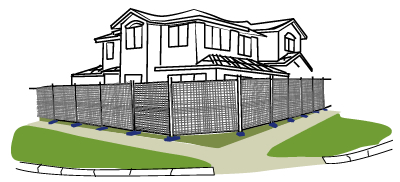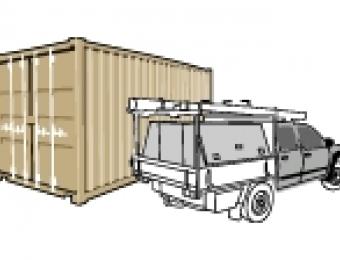
For the sake of both safety and security, construction sites in Australia need to be isolated from the public – this is typically achieved using temporary fencing that complies with a range Australian Standards. There are specific rules about what sorts of fencing can be used, including some that determine:
- how the fencing should be designed and constructed
- where it needs to be put up
- how it should affect traffic
- how strong and high it needs to be, and
- what sorts of signage it needs to display
- how high it should be
What sort of fence is required?
Most domestic residential construction sites are fenced off using portable aluminium cyclone fence (referred to as ‘open fencing’). This is normally erected with a construction wrap (e.g. shade cloth) attached, at least during demolition and excavation.
The shade cloth helps to contain dust and debris. Because it’s also likely to act as a sail, it may mean that the fence needs extra bracing to support it against wind.
Open fencing should never have barbed wire or barbed wire extensions on it, and must always have dog bars (i.e. railing enclosing the bottom part of the fence).
The second type of fencing that is used is called ‘solid fencing’ – more commonly referred to as ‘hoarding’. Hoarding is fencing that uses solid self-supporting panels which are either erected using their own supports, or attached to an overhead protective structure or scaffolding.
This type of barrier is more commonly used on larger developments, and those in town centres or where there’s a lot of pedestrian traffic. Solid fencing should be installed so that there aren’t any bolts or other dangerous protrusions sticking out.
Why are temporary fences necessary?
One reason that fencing is erected around construction sites is to create a barrier to confine any risk during demolition, excavation of the site, and when construction’s underway.
Another reason it’s installed is to prevent unauthorised access to the site by people who aren’t familiar with the state of the site, who aren’t wearing the right protective equipment and who aren’t properly trained on the necessary safety practices. Building sites can be dangerous places, and people who don’t know about the sorts of hazards they present could easily be seriously hurt.
Fencing also serves as a strong visual signal, alerting people to the fact that construction work’s being carried out at the site.
How is the site fenced off?
Where and how the fence is erected is very important. The specific rules relating to how it needs to be constructed may vary depending on where you live, but in most cases it needs to:
- cover the full length of the construction site wherever public access exists
- provide access in such a way as to ensure that there’s no hazard or nuisance to pedestrians or traffic
- be designed to ensure that it doesn’t interfere with the line of sight of motorists, pedestrians, traffic lights, crossings, ramps or cars entering or leaving the site
- have the necessary signage and traffic and pedestrian management devices, placed in a way that presents no hazard or obstruction to pedestrians or road traffic
- leave a gap of at least 1.5 metres between the fencing and the road for people to walk
- have gates and doors that only swing inwards
- have signs that show where traffic enters and leaves
- allow sufficient space so that vehicles can be loaded and unloaded inside of the property boundaries
- be between 1.8 and 2 metres tall
Council property (including footpaths)
If the fencing is going to encroach at all on council land (which includes footpaths and roads) the builder will normally need special permission from the local council to erect it, and will need to make special provisions for this, including temporary barriers and diversions, signage and possibly traffic control measures.
Planked crossings may be required across footpaths where vehicle access is required too, as well as some kind of protection for kerbs or gutters which may get damaged by heavy vehicles.
As the Principal Contractor, it’s the builder or developer’s responsibility to do a risk assessment, determine what’s required in terms of fencing and access control, and apply for the necessary permissions.






